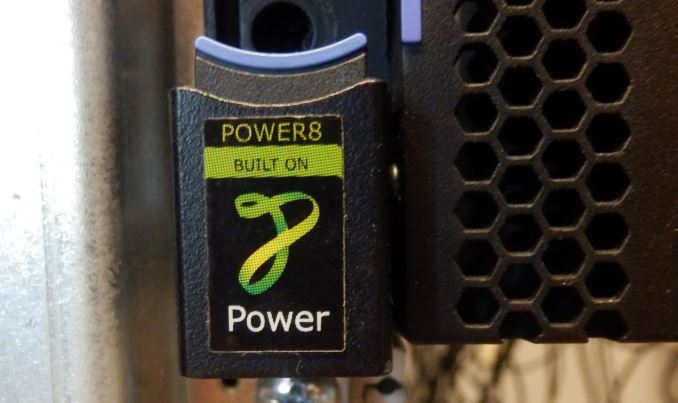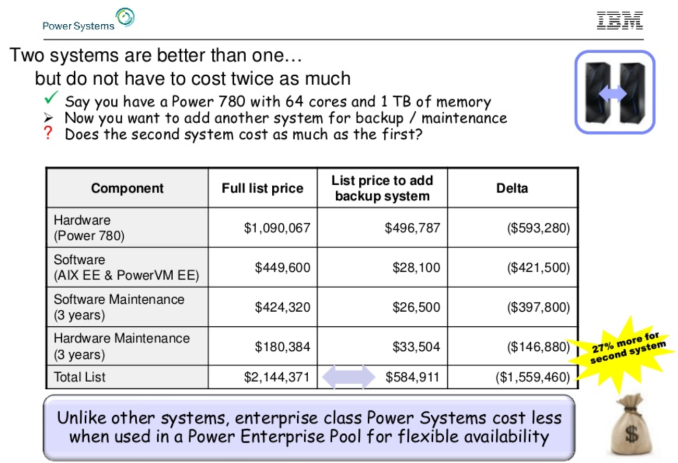The IBM POWER8 Review: Challenging the Intel Xeon
by Johan De Gelas on November 6, 2015 8:00 AM EST- Posted in
- IT Computing
- CPUs
- Enterprise
- Enterprise CPUs
- IBM
- POWER
- POWER8

Five years. That is how much time has passed since we have seen an affordable server processor that could keep up with or even beat Intel's best Xeons. These days no less than 95% of the server CPUs shipped are Intel Xeons. A few years ago, it looked like ARM servers were going to shake up the market this year, but to cut a long story short, it looks like the IBM POWER8 chip is probably the only viable alternative for the time being.
That was also noticeable in our Xeon E7 review, which was much more popular than we ever hoped. One of the reasons was the inclusion of a few IBM POWER8 benchmarks. We admit that the article was however incomplete: the POWER8 development machine we tested was a virtual machine with only 1 core, 8 threads and 2 GB of RAM, which is not enough to do any thorough server testing.
After seeing the reader interest in POWER8 in that previous article, we decided to investigate the matter further. To that end we met with Franz Bourlet, an enthusiastic technical sales engineer at IBM and he made sure we got access to an IBM S822L server. Thanks to Franz and the good people of Arrow Enterprise Computing Solutions, Arrow was able to lend us an IBM S822L server for our testing.
A Real Alternative?
Some of you may argue that the POWER based servers have been around for years now. But the slide below illustrates what we typically associated IBM's POWER range with:
Proudly, the IBM sales team states that you can save 1.5 million dollars after you have paid them 2 million dollars for your high-end 780 system. There is definitely a market for such hugely expensive and robust server systems as high end RISC machines are good for about 50,000 clients. But frankly for most of us, those systems are nothing more than an expensive curiosity.
Availability can be handled by software and most of us are looking/forced to reduce our capital expenses rather than increase them. We want fast, "reliable enough" servers at low costs that are easy to service. And that is exactly the reason why the single and dual sockets Xeon servers have been so popular the past decade. Can an IBM POWER server be a real alternative to the typical Xeon E5 server? The short but vague answer: a lot has changed in the past years and months. So yes, maybe.











146 Comments
View All Comments
Michael Bay - Saturday, November 7, 2015 - link
You are probably still hurry.Or just not civilized enough.
JohanAnandtech - Saturday, November 7, 2015 - link
I have to disagree with "only old legacy". One of things I really want to tackle is running Apache Spark on POWER. Spark is one of the most exciting Big Data tools, it is a very modern piece of software. IBM claims that the POWER8 is very good at it, and I want to check that.Jake Hamby - Friday, November 6, 2015 - link
Very interesting review! I've been a PowerPC fan for many years. I even bought a used PowerMac Quad G5 a few years ago to hack on FreeBSD for PowerPC with (much cheaper than the latest gear).My only suggestion is that I would love to see you run the same benchmarks with big-endian Linux, since the entire stack is so much more mature for PPC than LE Linux, which as you mention wasn't even supported for many years.
Anyone running Java workloads in particular has no business using LE Linux when Java itself uses big-endian data formats, and IBM has 15+ years of tuning the JDK for big-endian Linux & AIX.
TL;DR is the biggest advantage of LE Linux is that it's easier to port large custom apps that were written for x86 and have too many byte ordering issues to fix. The original motivation to make the PowerPC architecture bi-endian instead of big-endian was the hope of a Windows NT port. When Apple went their own way with hardware, and IBM focused on servers, little-endian mode disappeared. It's good that POWER8 supports LE mode again, for customers who really need it, but it's far from the normal mode.
PS. I've been working on fixing bugs in Clang/LLVM for PowerPC arch (32/64-bit). FreeBSD recently switched from GCC 4.2.1 (final GPLv2 version) to Clang as the default system compiler on x86, but LLVM has some code gen bugs for PowerPC that I'm hoping to squash. For now, it doesn't work well enough for me to recommend trying to use Clang as an alternative to GCC for POWER8 benchmarking. Certainly not for little-endian mode.
Jake Hamby - Friday, November 6, 2015 - link
BTW, the name of the instruction set architecture is still PowerPC, even though IBM's chips are the POWER series. The predecessor architecture was named POWER, so I always write PowerPC to avoid confusion when referring to the instruction set. The PowerPC 970MP chips in my Quad G5 (2 x dual-core) are a derivative of POWER4.ZeDestructor - Saturday, November 7, 2015 - link
That would be incorrect actually (since they changed since in 2006).The ISA is (currently) named the Power ISA (previously "PowerPC ISA", the "ISA" bit is quite important to denote hardware architecture vs ISA) (with the current being Power ISA 2.07 B)
Underneath each ISA, there are a variety of designs that all have nice, different names, from POWER1-8, PowerPC (including the various variants used by Apple, like the G5/970), Power-PC-AS, Cell, most LSI controllers (mostly PowerPC 440 (Power ISA 2.03) based, afaik) etc.
Source: https://en.wikipedia.org/wiki/Power_Architecture
tipoo - Friday, November 6, 2015 - link
I wish I had a what-if machine to see what IBM would be making had they stayed in the consumer space (well, discounting some consoles they're in - currently only the Wii U on an ancient PowerPC 750 modified for tri-core). And how chunky that PowerBook G5 would have been :Phttp://forums.macrumors.com/attachments/powerbook_...
DanNeely - Friday, November 6, 2015 - link
Probably they'd've ended up making architectural tradeoffs that made their cores a lot more like Intel. As it is, they can optimize their designs for very high power isn't a problem because the power cost is a small fraction of the TCO on one of their monster servers; and a relatively minor concern for consoles (ie just dropping the core count gets them desktop CPU level thermals which are good enough). If they were still selling to Apple, they'd need to be well optimized for performance at only a few watts/core for laptops. Huge L1 caches and massive SMT would be gone because they'd devour battery power to little benefit on systems that generally functioned at very low average CPU loads vs on a mega server or mainframe where if you're not pushing enough work onto it to keep it at a high load level you're doing it wrong.Jake Hamby - Friday, November 6, 2015 - link
Yep. It feels a lot like Apple's own 64-bit ARM cores have approached the old G5 (PPC 970) from the other end of the power envelope.Kevin G - Saturday, November 7, 2015 - link
While Apple's engineers were given the task of a PowerBook G5, they new it could never happen due to thermals and a very arcane chipset. Case in point, the PowerPC 970 could not boot itself: it needed a service processor to calibrate and initialize the frontside bus for the processor before it could take control. Justifiable for servers but unnecessary for a consumer laptop.The expected Powerbook G5's were supposed to be using PA-Semi chips. Due to IBM not meeting Apple's goals, they switched to Intel and the PA-Semi deal fell through with it. However, their dealings with Apple did lead to Apply buying them out a few years later to help design custom ARM SoCs and eventually the custom ARM cores used in the iPhone/iPad of today.
JohanAnandtech - Saturday, November 7, 2015 - link
Would love to hear some thoughts on what the possible problems could arise if we rerun our tests on BE linux. Because our best benchmarks are all all based upon some data stored on our x86 fileservers - so they are probably stored in LE.